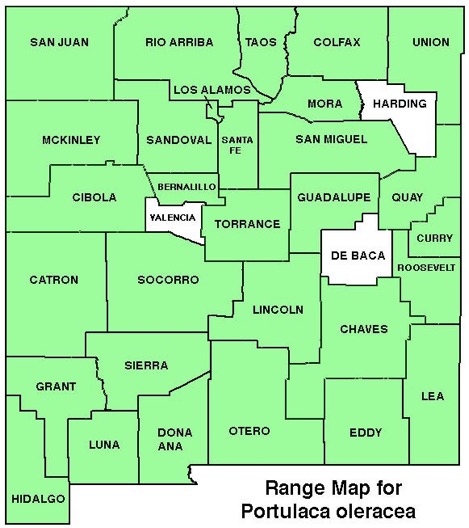WILDFLOWERS OF NEW MEXICO

People around the world step over and on this sprawling and mat-forming succulent without noticing it. The fleshy, prostrate, hairless branches reach 24-inches long with tiny yellow flowers and round-tipped, succulent leaves. In times past this common yard weed, now fastidiously eradicated from New Mexico’s popular gravel landscapes, was loved raw and as a nutritious pot herb. Though considered invasive, it supports local ecosystems as one of the many host plants for the hornworm larva of the White-lined Sphinx moth (Hyles lineata), an important pollinator for evening primroses, sacred datura, desert 4 o’clocks, and other long-throated, tubular flowers.
FLOWER: May–November. Tiny, 1/8–3/8-inch wide ( 3–9 mm) flowers with 5 yellow petals are surrounded by clusters of leaves. Fruit is a capsule 1/8–1/4 inch diameter (3–8 mm) with numerous tiny seeds.
LEAVES: Alternate. The numerous succulent, oval to spoon-shaped leaves are flat and 1/4–1-inch long (6–25 mm).
HABITAT: Sunny sandy, gravelly, clay soils, yards, gardens, roadsides, disturbed areas; desert grassland and scrub, pinyon-juniper woodlands.
ELEVATION: 3,800–8,500 feet.
RANGE: Naturalized nationwide.
SIMILAR SPECIES: Silk-cotton Purslane, P. halimoides, scattered statewide, has yellow flowers and narrow tubular leaves 1/8-inch thick (3 mm) with hairy axils, and often with reddish stems. Shaggy Purslane, P. pilosa, scattered statewide, has pink to purple petals and tubular leaves with tufts of hair in the axils.
NM COUNTIES: Nearly statewide (not reported in De Baca, Harding, Valencia counties) in low- to mid-elevation arid and disturbed habitats.
NOTES: This aggressive plant is considered “one of the 10 most noxious weeds in the world,” yet it’s high in iron, protein, and has the “highest content of omega-3 fatty acids and antioxidants of any leafy vegetable tested.” The tart flavor comes from oxalic acid, which if over-consumed can cause painful electrolytic imbalances.

COMMON PURSLANE
PORTULACA OLERACEA
Purslane Family, Portulacaceae
Annual herb, introduced invasive

THE CONTENTS OF THIS WEBSITE ARE COPYRIGHTED AND CANNOT BE USED
WITHOUT PERMISSION OF GEORGE OXFORD MILLER



Young, succulent plants are nutritious raw or as a pot herb.
EMAIL ME